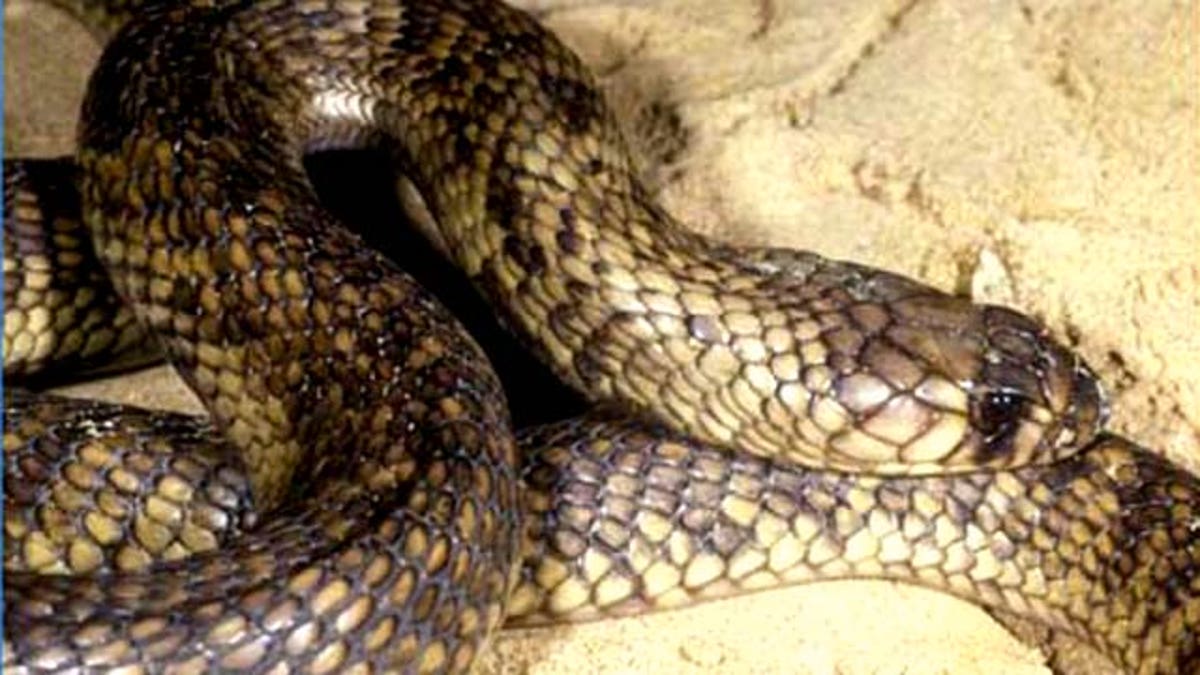
An Egyptian cobra, similar to the one seen here, has escaped from on off-exhibit enclosure at the Bronx Zoo March 25. The exhibit will remain closed until the snake is found, museum officials said. (Mark O'Shea/WHO)
The deadly baby cobra on the loose at New York's Bronx Zoo has everyone wondering -- how do you catch a 20-inch-long, pencil-thin snake that can squeeze into the tiniest crack or crevice?
Snake experts, known as herpetologists, tell FoxNews.com that finding the months-old female Egyptian cobra is no easy task.
"Snakes are escape artists," said Rulon Clark, a biology professor at San Diego State University. "It's tough. Their bodies are compressible and can fit in extremely small openings."
The missing cobra, who weighs less than 3 ounces, disappeared from her enclosure Friday inside the zoo's Reptile House. Zoo officials say they are confident the snake is not in an area accessible to the public and have put in place a tracking system to monitor its movement, though zoo director Jim Breheny did not elaborate on the plan.
For one snake expert, the most effective strategy calls for water.
"I would try to set up a trap that had water in it because the snake would eventually go to it," said Laurie Vitt, a zoology professor at the University of Oklahoma. "Snakes require water."
"If it isn't going to come to water, it’s probably going to die from dehydration within a week or two weeks," Vitt said, though he added that Egyptian cobras are native to arid climates and "can probably go a long time without it."
Other herpetologists, like Clark, propose setting up "funnel traps" in the holding area of the Reptile House where the venomous reptile is believed to be hiding.
Such traps call for a box attached to a funnel through which snakes can enter. The funnels are often placed along hard surfaces, like rocks or fences, and are ideal for catching smaller snakes. The slope of the funnel makes it difficult for snakes to get out.
"Snakes like to move along surfaces," said Clark, "I would set up a series of funnel traps along the walls and just hope that it comes out to explore and falls into one of them."
Snake experts say that in some instances "pit tags" or "transmitters" are used to track snake movements, but both Clark and Vitt said such devices are more likely to be used in the wild.
"Without some kind of tracking device implanted in the snake, I don’t know how you’d track it," said Clark.
Stan Mays, curator of herpetology at the Houston Zoo, said other methods for catching snakes include laying down florescent powders or warming up areas with heating pads.
The female cobra, who zoo officials say has no name, can grow up to 8-feet long and produces a venom that is deadly. Snake experts describe the poison as "neurotoxic" and say the venom can kill a human by causing complete respiratory failure.
Experts, however, say the snakes aren't likely to attack people unless the reptiles feel threatened and that the Bronx Zoo baby cobra poses a small risk, if any, to its handlers.
"It's not going to be a threat unless someone is really trying to mess with it," said Mays.
For now, officials say patience is key in catching the cobra.
"As her comfort level rises, she will begin to move around the building to seek food and water," Breheny said in a statement Monday.





















